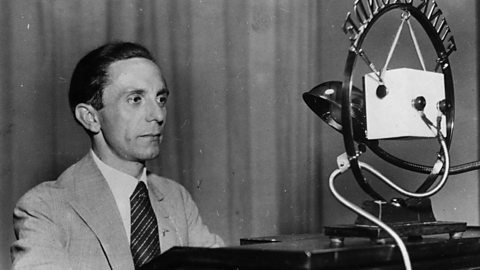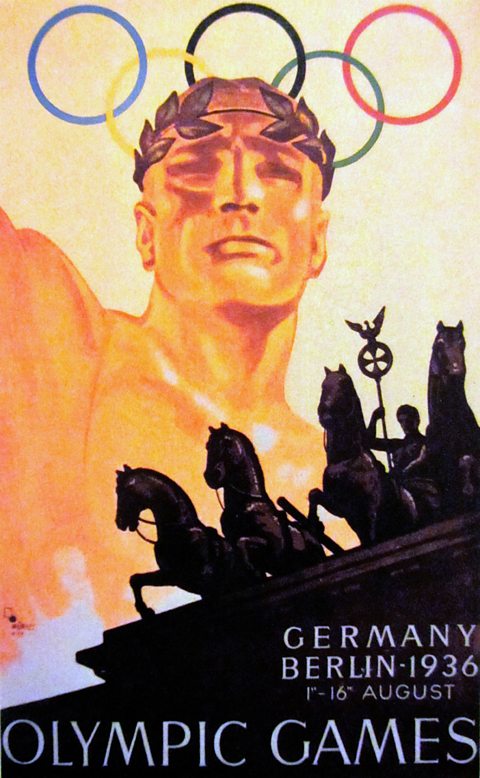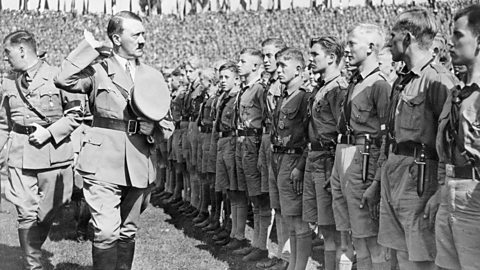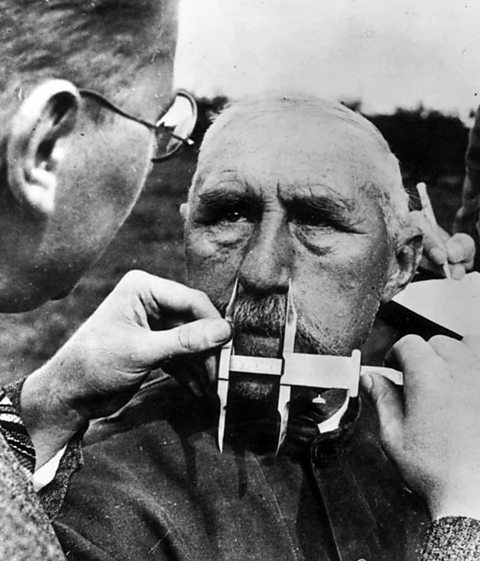Life in nazi germany
The Police State, propaganda and control
The Police State
By August 1934 Hitler was a dictator with absolute power. In order to maintain this power he needed organisations that could control the population to ensure absolute loyalty to the Führer. After the demise of the SA on the Night of the Long Knives, there were three main interlinked organisations (in addition to the regular German police force) involved in controlling the German people through spying, intimidation and, if necessary, imprisonment:
Schutzstaffel (SS) - Led by Heinrich Himmler, the SS was the most important of these organisations and oversaw the others. Initially set up as Hitler’s personal bodyguard service, the SS was fanatically loyal to the Führer. It later set up concentration camps where ‘enemies of the state’ were sent
Gestapo - This was the Nazis’ secret police force. Its job was to monitor the German population for signs of opposition or resistance to Nazi rule. It was greatly helped by ordinary German people informing on their fellow citizens.
Sicherheitsdienst (SD) - This was the intelligence gathering agency of the SS. It was responsible for the security of Hitler and other top Nazis and was led by Himmler’s right hand man, Reinhard Heydrich.
Revision tip:
A good mnemonic to help you remember some of the key features of this topic is:
Himmler’s - Head of the police state
Sight – The SS
Gradually – The Gestapo
Spreads – The SD
Nazi control of the legal system
The Nazis quickly swept away many of the freedoms that Germans had enjoyed under the Weimar constitution. The party’s control of the legal system made opposition to the regime very difficult indeed:
Judges had to swear an oath of loyalty to Hitler and were expected to act always in the interests of the Nazi state.
All lawyers had to join the Nazi Lawyers' Association, which meant they could be controlled.
The role of defence lawyers in criminal trials was weakened.
Standard punishment for crimes were abolished and so local prosecutors could decide what penalties to impose on those found guilty.
These changes more than halved the number of criminal offences between 1933 and 1939, whilst the number of crimes that carried the death penalty increased from three to 46. Many convicted criminals were not released at the end of their sentences but instead were moved to the growing number of concentration camps being established by the SS.
Goebbels and the Ministry of Propaganda

Figure caption,
Joseph Goebbels
Hitler and the Nazi Party were a constant presence in the life of the German people, with:
The infamous Swastika symbol appearing on every government uniform and public building.
Pictures of Hitler displayed everywhere.
Germans having to greet each other with a ‘Heil Hitler’ raised arm salute.

The government department responsible for all of this was the Ministry of Enlightenment and Propaganda, headed by Dr Joseph Goebbels. It aimed to brainwash people into obeying the Nazis and idolising Hitler. Its methods included:
Censorship of the press. All newspapers were controlled by the government and could only print stories favourable to the Nazi regime.
Control of radio broadcasts. Radios were sold very cheaply so that most Germans could afford one. All radio output was controlled by Goebbels’ ministry through the Reich Broadcasting Corporation.
Mass rallies. These public displays of support for Nazism involved music, speeches and demonstrations of German strength. The biggest one was held each year in August at Nuremberg.
Use of sports events. Berlin hosted the Olympics of 1936, which the Nazis used as an opportunity to showcase the success of the regime and to demonstrate the superiority of the Aryan race. The victories of the African-American athlete Jesse Owens for the USA infuriated the Nazi leadership.
Loudspeakers in public places also blared out Nazi propaganda. Much of the information Germans received reinforced the message of Aryan racial superiority whilst demonising the Jews and other ‘enemies’ of the regime.
Nazi control of culture and the arts
Type | German influence |
Art | The Weimar period had seen a flourishing of German art, much of which was abstract. Hitler saw this modern art as ‘degenerate’ and over 6500 works of art were removed from display across Germany. Hitler encouraged ‘Aryan art’ instead, which showed the physical and military power of Germany and the Aryan race. |
Architecture | Hitler was very interested in architecture and believed it could be used to project the power of the Nazi regime. The most important architect of the period was Albert Speer, who redesigned Berlin, as well as designing the stadium in Nuremberg where annual rallies were held. |
Literature | Nazis ceremonially burned thousands of books in 1933 that were viewed as being subversive or as representing ideologies opposed to Nazism. These included books written by Jewish, pacifist, classical, liberal, anarchist, socialist, and communist authors. |
Theatre | Works by certain playwrights were banned. Nazi-produced political plays and musicals were not very popular so the regime allowed classic plays by the likes of Shakespeare to be performed. |
Film | To make sure that film served the goals of propaganda, the Nazi Party gradually took over film production and distribution. A state-run professional school for politically reliable film-makers was founded, and membership of an official professional organization (Reichsfilmkammer) was made compulsory for all actors and film-makers. The Nazi leaders often used film stars, like Lil Dagover, to help promote the popularity of the party in Germany. |
Music | In classical music, works by Jewish composers like Mendelssohn and Mahler were banned and the works of the German composer Wagner were promoted, gaining huge popularity. The Nazis were strongly opposed to jazz music, which they referred to as 'Negro music' and called it 'degenerate'. |
The Nazis’ interest in and influence on all of these areas demonstrates the extent to which the party sought to control German life and win over the population to the Nazi cause.
Employment and living standards
The German people had suffered terribly during both the First World War and the Depression and a huge part of the Nazis’ appeal was that they promised to make Germany’s economy strong again. Hitler aimed for full employment and by 1939 there was virtually no official unemployment in Germany. He also wanted to make Germany self-sufficient (a concept known as autarky), but the attempt to do so was ultimately unsuccessful.
How Hitler increased employment
He began a huge programme of public works, which included building hospitals, schools, and public buildings such as the 1936 Olympic Stadium. The construction of the autobahns created work for 80,000 men.
Rearmament was responsible for the bulk of economic growth between 1933 and 1938. Rearmament started almost as soon as Hitler came to power but was announced publicly in 1935. This created millions of jobs for German workers.
The introduction of the National Labour Service (NLS) meant all young men spent six months in the NLS and were then conscripted into the army.
Invisible employment
Although Germany claimed to have full employment by 1939, many groups of people were not included in the statistics, including:
The 1.4 million men in the army at this time.
Jews who were sacked and their jobs given to non-Jews.
Women who were encouraged to give up their jobs to men.
Autarky
The policy of autarky was a failure. In 1937, Hermann Göring was made Economics Minister with the job of making Germany self-sufficient in four years. However, the measures he introduced, such as tighter controls on imports and subsidies for farmers to produce more food, were not successful. By the outbreak of World War Two Germany was still importing 20 per cent of its food and 33 per cent of its raw materials.
Impact of Nazi Economic Policies on German people
Despite the loss of freedom, life improved in Germany for many ordinary people who were prepared to conform and look the other way. Everybody had a job and a wage.
Nazi economic policies had different effects on different groups in society:
Big businesses - By 1937 monopolies (which the Nazis had promised to tackle) controlled over 70 per cent of production. Rearmament from 1935 onwards boosted profits and managers of the major industrial companies saw their wages rise by 50 per cent between 1933 and 1939.
Small business - Rules on opening and running small businesses were tightened, which resulted in 20 per cent of them closing.
Farmers - Having been one of the main sources of their electoral support during their rise to power, farmers benefitted under the Nazis. By 1937, agricultural prices had increased by 20 per cent and agricultural wages rose more quickly than those in industry. The Hereditary Farm Law of 1933 prevented farms from being repossessed from their owners, which gave farming families greater security.
Industrial workers

Before 1933 the Nazis had lacked support amongst the workers, who tended to vote for the communists or the Social Democratic Party. The needs of German rearmament made it important that workers were productive and controlled. so the Nazis set up three organisations that would manage German workers:
The Labour Front. This was a Nazi organisation that replaced Trades Unions, which were banned. It set wages and nearly always followed the wishes of employers, rather than employees.
Strength Through Joy. This scheme gave workers rewards for their work - evening classes, theatre trips, picnics, and even very cheap or free holidays.
Beauty of Labour. The job of this organisation was to help Germans see that work was good, and that everyone who could work should. It also encouraged factory owners to improve conditions for workers.
Those working in the rearmament industries aside, living standards did not really improve for German workers under the Nazis. From 1933 to 1939 wages fell, the number of hours worked rose by 15 per cent, serious accidents in factories increased and workers could be blacklisted by employers if they attempted to question their working conditions.
Women
The Nazis had clear ideas of what they wanted from women. They were expected to stay at home, look after the family and produce children in order to secure the future of the Aryan race.
Hitler believed women’s lives should revolve round the three 'Ks': kirche, kinder, kuche
Marriage and family
Hitler wanted a high birth rate so that the Aryan population would grow. He tried to achieve this by:
introducing the Law for the Encouragement of Marriage which gave newlywed couples a loan of 1,000 marks, and allowed them to keep 250 marks for each child they had
giving an award called the Mother’s Cross to women who had large numbers of children
allowing women to volunteer to have a baby for an Aryan member of the SS
Employment
Measures were introduced which strongly discouraged women from working, including:
the introduction of the Law for the Reduction of Unemployment, which gave women financial incentives to stay at home
not conscripting women to help in the war effort until 1943
However, female labour was cheap and between 1933 and 1939 the number of women in employment actually rose by 2.4 million. As the German economy grew, women were needed in the workplace. Germany also needed women in work as production and manufacturing geared up in readiness for war.
Appearance
Women were expected to emulate traditional German peasant fashions - plain peasant costumes, hair in plaits or buns and flat shoes. They were not expected to wear make-up or trousers, dye their hair or smoke in public. They were discouraged from staying slim, because it was thought that thin women had trouble giving birth.
Nazi aims and policies towards the young

Young people were very important to Hitler and the Nazis. Hitler spoke of his Third Reich lasting for a thousand years and to achieve this he would have to ensure German children were thoroughly indoctrinated into Nazi ideology.
To this end, from the age of 10 boys and girls were encouraged to join the Nazis’ youth organisation, the Hitler Youth (the girls’ wing of which was called the League of German Maidens). Membership from age 10 was made compulsory in 1936 and by 1939 90 per cent of German boys aged 14 and over were members.
The Hitler Youth | The League of German Maidens |
Its aim was to prepare German boys to be future soldiers | Its aim was to prepare German girls for future motherhood |
Boys wore military-style uniforms | Girls wore a uniform of blue skirt, white blouse and heavy marching shoes |
Activities centred on physical exercise and rifle practice, as well as political indoctrination | Girls undertook physical exercise, but activities mainly centred on developing domestic skills such as sewing and cooking |
Nazi control of the young through education
As well as influencing the beliefs of young Germans through the Hitler Youth, schools indoctrinated young people into the political and racial ideas of Nazism.
All teachers had to join the Nazi Teachers’ Association, which vetted them for political and racial suitability.
The curriculum was altered to reflect Nazi ideology and priorities:
History - lessons included a course on the rise of the Nazi Party.
Biology - lessons were used to teach Nazi racial theories.
Physical Education - German schoolchildren had five one-hour sports lessons every week.
Chemistry and Mathematics - were downgraded in importance.
Again, the aim was to brainwash children so that they would grow up accepting Nazi ideas without question.
Nazi policies towards the Catholic and Protestant Churches
Nazi policies towards the Catholic and Protestant Churches
There were approximately 45 million Protestants and 22 million Catholic Christians in Germany in 1933. Hitler saw Christianity as a threat and a potential source of opposition to Nazism because it emphasised peace. The Nazis tried to control the Churches with policies and bargaining.
Control of the Churches
A state Reich Church under the leadership of the Nazi Bishop Ludwig Müller was established to unify the different branches of Protestantism. This enabled the Nazis to use a group called the ‘German Christians’ within the Reich Church to promote Nazi ideas.
In 1933 Hitler agreed a Concordat with the Pope, which said that he would not interfere in the running of the Catholic Church if it stayed out of political matters. Hitler didn’t keep his side of the bargain, however, as the Nazis attempted to infiltrate the Church and spread their propaganda.
Nazi attempts to supress the Churches
The Reich Church attempted to ban the use of the Old Testament in religious services as it was considered a ‘Jewish book’. Eight hundred Pastors of the Confessional Church, a non-conforming Protestant group, were arrested and sent to concentration camps.
The Nazis attempted to stop Catholics using the crucifix in church, though this attempt was not successful. Catholic schools and youth organisations were supressed, with German children being educated in state schools and taught a Nazi curriculum, as well as being expected to join the various branches of the Hitler Youth. Catholic newspapers were banned and four hundred Catholic priests were sent to Dachau concentration camp.
Impact of the Nazis actions
In 1937 Hitler was forced to return control of the Church to the old Protestant leadership, in return for a promise that the Church would stay out of politics.
Attendance at Catholic churches increased substantially under the Nazis, especially during World War Two, showing that Hitler’s attempts to reduce the influence of religion in Germany was ultimately unsuccessful.
Both Protestant and Catholic clergy played a large role in opposing Hitler and the Nazis, for which they often paid a high price.
Opposition from the Churches, youth groups and workers
Historians tend to define ‘opposition’ in Nazi Germany as any acts which openly defied the regime, while 'resistance' is taken to mean active attempts to overthrow Hitler and the Nazis. There were obviously a great deal more of the former than of the latter. However, it is also generally acknowledged that the regime was widely accepted and enjoyed much popular support.
The extent of support for the Nazi regime
It is difficult to know exactly how popular the regime was as Hitler’s police state made it very difficult to express opposition and Nazi propaganda portrayed the Führer as his people’s saviour. However, it is clear that the Nazis were the most popular party when they came to power and many Germans welcomed the stability and economic growth an authoritarian regime brought.
In general, Germans were happy to trade the freedom and democracy of Weimar for the certainty and security Hitler brought. His regime restored Germany’s international prestige through rearmament and the dismantling of the Treaty of Versailles. The sheer scale of propaganda - especially that directed towards German children - meant that many more Germans became active Nazi Party members and were convinced of Hitler’s greatness.
Opposition from the Churches
Protestantism
Many Protestant pastors, led by Martin Niemöller, formed the Confessional Church in opposition to Hitler's Reich Church. Niemöller was held in a concentration camp during the period 1937-1945 and a total of 800 clergy were sent to camps.
Another Protestant pastor and member of the Confessional Church, Dietrich Bonhöffer, was linked to the 1944 bomb plot and was executed.
In 1937 Hitler restored the Protestant church’s independence in return for a guarantee that it would not interfere in politics, an agreement similar to his Concordat with the Pope.
Catholicism
Despite the concordat, some Catholic priests opposed Hitler. In 1937, the Pope's message 'With Burning Concern' attacked Hitler as 'a mad prophet with repulsive arrogance' and was read in every Catholic Church.
The Catholic Archbishop of Munster, von Galen, led a successful campaign to end euthanasia of mentally-disabled people.
400 German Catholic priests were imprisoned in Dachau concentration camp by the regime.
Opposition from the young
The main youth opposition group was the Edelweiss Pirates, based in the Rhineland. They reacted to the discipline of the Hitler Youth by daubing anti-Nazi slogans and singing pre-1933 folk songs. In 1942 over 700 of them were arrested and in 1944, the Pirates in Cologne killed the Gestapo chief, so the Nazis publicly hanged 12 of them.
The White Rose group was formed by students at Munich University in 1943. They published anti-Nazi leaflets and marched through the city in protest at Nazi policies. Its leaders, brother and sister Hans and Sophie Scholl, were arrested to and sentenced to the guillotine.
During the war, ‘Swing Youth’ and ‘Jazz Youth’ groups were formed. These were young people who rejected Nazi values, drank alcohol and danced to jazz. The Nazis rejected jazz music as degenerate and called it 'Negro music', using their racial ideas against this cultural development. These youths were closely monitored by the Gestapo, who regularly raided illegal jazz clubs.
Opposition from workers
Perhaps the most widespread and persistent opposition to the Nazi regime came from ordinary German workers, often helped by Communists, who posted anti-Nazi posters and graffiti, or organised strikes. In Dortmund the vast majority of men imprisoned in the city’s jail were industrial workers. Workers went on strike over high food prices in 1935 and during the Berlin Olympics in 1936.
In 1944, a group of army officers tried to assassinate Hitler. A bomb was planted by Colonel Stauffenberg at meeting attended by Hitler. It exploded, but Hitler survived. In retaliation, Stauffenberg was shot the same day and 5,000 people were executed in the crackdown on opposition that followed.
The persecution of minorities
Hitler and the Nazis had firm views on race. They believed that certain groups were inferior and were a threat to the purity of the Aryan race. There were many groups who were targeted for persecution, including Slavs (Eastern Europeans), gypsies, homosexuals and the disabled - but none more so than the Jews.
Nazi racial beliefs

The Nazis’ racial philosophy taught that Aryans were the master race and that some races were ‘untermensch’ (sub-human). Many Nazi scientists at this time believed in eugenics, the idea that people with disabilities or social problems were degenerates whose genes needed to be eliminated from the human bloodline. The Nazis pursued eugenics policies vigorously.
Policy of persecution
Sterilisation - In order to keep the Aryan race pure, many groups were prevented from reproducing. The mentally physically and disabled, including the deaf, were sterilised, as were people with hereditary diseases.
The murder of people with disabilities - The Nazis’ false belief in genetic superiority led to the persecution and murder of people with disabilities. Euthanasia is the act of deliberately ending a person’s life to relieve suffering. However, this is very different to the Nazi euthanasia programme, which was the systemic and state sponsored murder of people with disabilities. At least 200,000 people with disabilities were murdered by the Nazi regime.
Concentration camps - Homosexuals, prostitutes, Jehovah's Witnesses, gypsies, alcoholics, pacifists, beggars, hooligans and criminals were often rounded up and sent away to camps. During World War Two 85 per cent of Germany's gypsies died in these camps.
The Nazis’ persecution of the Jews
The group most heavily targeted for persecution by the Nazis were the Jews of Germany. The outbreak of World War Two brought the horror of mass killings and the Final Solution, but the period 1933 saw a gradual increase in persecution, reaching a turning point during Kristallnacht in November 1938:
1933
Nazis organised a boycott of Jewish businesses.
Books by Jewish authors were publicly burnt.
Jewish civil servants, lawyers and teachers were sacked.
Race science lessons were introduced, teaching that Jews were sub-human.
1935
The Nuremberg Laws formalised anti-Semitism into the Nazi state by:
Stripping Jews of German citizenship.
Outlawing marriage and sexual relations between Jews and Germans.
Taking away from Jews all civil and political rights.
1938
Jews could not be doctors.
Jews had to add the name Israel (men) or Sarah (women) to their name.
Jewish children were forbidden to go to school.
Kristallnacht - 9 November. The SS organised attacks on Jewish homes, businesses and synagogues in retaliation for the assassination of the German ambassador to France by a Jew.
Key fact
Many Jews saw the events of Kristallnacht as a turning point. Up until then there had been a progressive erosion of their rights but Jews had not been physically threatened or attacked. When their businesses and homes were destroyed and their synagogues were burnt down, many concluded that their time in Germany was up. Those who were able to fled and a scheme to evacuate Jewish children to Britain, called the Kindertransport, began.
1939
Jews were forbidden to own a business, or even a radio.
By the outbreak of World War Two in September 1939, the Jews were stateless, their employment options in Germany were severely restricted and they feared for their safety.